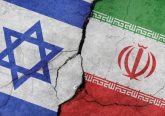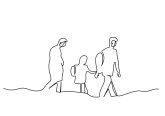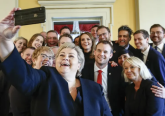 On the 31 July 2011, photographer Miki Kratsman, head of the photography department of the Bezalel Academy of Art and Design, learnt that he was the recipient of the EMET Prize for Art, Science and Culture awarded by the Prime Minister of Israel. Kratsman expressed his surprise (http://www.haaretz.co.il/hasite/spages/1239559.html): “when a minister like Liebermann is in office, and people understand his logic and do not go out to the streets and protest against the horrible things he does, I am awarded with a prize”. There is, indeed, a sharp opposition between the brutality and ruthlessness of the current Israeli government, Kratsmans’ bold interventions into the seemingly stable status quo, and the decision to award him a with prize. In a long standing collaboration with journalist Gideon Levi in the column The Twilight Zone (published every Friday in the weekend supplement of the Haaretz newspaper) he captured scenes of the Israeli occupation in the Palestinian Authority and brought them into Israeli homes.
On the 31 July 2011, photographer Miki Kratsman, head of the photography department of the Bezalel Academy of Art and Design, learnt that he was the recipient of the EMET Prize for Art, Science and Culture awarded by the Prime Minister of Israel. Kratsman expressed his surprise (http://www.haaretz.co.il/hasite/spages/1239559.html): “when a minister like Liebermann is in office, and people understand his logic and do not go out to the streets and protest against the horrible things he does, I am awarded with a prize”. There is, indeed, a sharp opposition between the brutality and ruthlessness of the current Israeli government, Kratsmans’ bold interventions into the seemingly stable status quo, and the decision to award him a with prize. In a long standing collaboration with journalist Gideon Levi in the column The Twilight Zone (published every Friday in the weekend supplement of the Haaretz newspaper) he captured scenes of the Israeli occupation in the Palestinian Authority and brought them into Israeli homes.
Over the last three decades Kratsman has provided Israelis – and his audience around the world – with a unique visual conceptual language, illuminating clandestine sites of action and giving voice to the sometimes mute protagonists of the Israeli-Palestinian conflict. Looking at Kratsman’s body of work one can see where his surprise at the announcement of the EMET prize comes from: his sensitive take on the Israeli occupation in Palestine makes him seem far from being the establishment favourite. Nevertheless, it is impossible to ignore his contribution to the public discourse in Israel. 2011 will definitely be a memorable year for Kratsman: earlier in the year he learnt that he was the recipient of the prestigious Robert Gardner award given by the Peabody museum (part of Harvard university).
Kratsman’s photographs have the remarkable quality of causing the spectator intense discomfort whilst making it impossible to look away. This juxtaposition is a key part of his visual language, which is rooted in oppositions, and the question of how they can be resolved. By making the invisible visible, his body of work makes us consider the very concept of seeing: who we see, who we want to see, who we might not want to see, and upon whom we should fix our gaze. But instead of making the viewer feel alienated by this, his work shows us the very human threads that bind us all together. Whether from New York, Bangkok, Tel Aviv or Gaza, we can look all at his photographs and see our own lives within them. We see human beings, their artefacts and social structures, and their direct everyday lives. More than being a purely political artist, Kratsman uses his lens to illuminate the subtleties of being human. Philosopher Jacques Rancière writes: “What is common is ‘sensation’. Human beings are tied together by a certain sensory fabric, a certain distribution of the sensible, which defines their way of being together; and politics is about the transformation of the sensory fabric of ‘being together’,” (The Emancipated Spectator, p. 56) and Kratsman’s photographs do just that; they allow us as spectators to look into the experience of being ‘the other’, until perhaps we feel they are not ‘other’ at all. At the same time, Kratsman’s work also exposes the voids, the empty spaces. They show how fragile this sense of ‘being together’ really is.
In addition to working on several photographic series, Kratsman is currently revisiting a series of photographs he took in 2007 in the Genin refugee camp, and asking his subjects to mark those who were in the photos and are no longer alive. This project highlights the power of photography, and touches on one of the most fundamental demarcations of all: that between the living and the dead. By revisiting the place, the photographintervenes into the distinction between those who are there and those who are absent.. Visibility is not simply the mirror image of invisibility; it is sometimes enabled by it, and in profoundly unjust ways. Places become defined by their absent protagonists, by the people who were there and were subsequently removed – or, perhaps more accurately, who were displaced (Displaced is the title of another Series of portraits by Kratsman.) As political theorist Bonnie Honig writes in her Political Theory and the Displacement of Politics: “… the always imperfect closure of political space tends to engender remainders and that, if those remainders are no engaged (…) may return to haunt and destabilize the very closures that deny their existence” (Political theory and the displacement of politics, p.15). To me, Kratsman’s photographs work in the same way: they force the viewer to think about what has been displaced and where the actual boundaries of political life lie. The place is defined by the displacement of the people who allowed the picture to happen, of the names that we might not want to remember, of the faces that the photograph taken today cannot capture. In a way, Kratsman’s political photographs are disturbing because they force us to think of what’s missing in the frame, what has been displaced, always haunting the fragile boundaries of the political and the non-political, and forcing us to rethink the durability of trying to demarcate the political.
Dana Mills is a DPhil candidate in Politics at the University of Oxford.
Miki Kratsman’s photos can be seen here:
http://www.chelouchegallery.com/artistWorks.php?the_group=73&id=49







No Comment